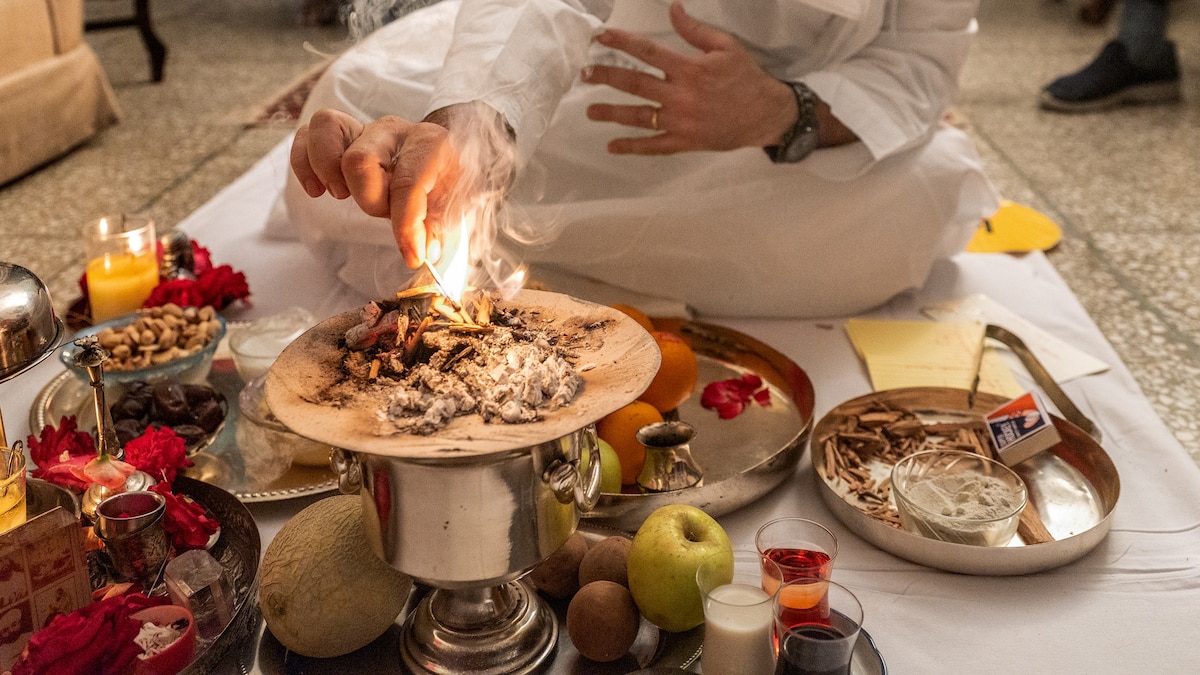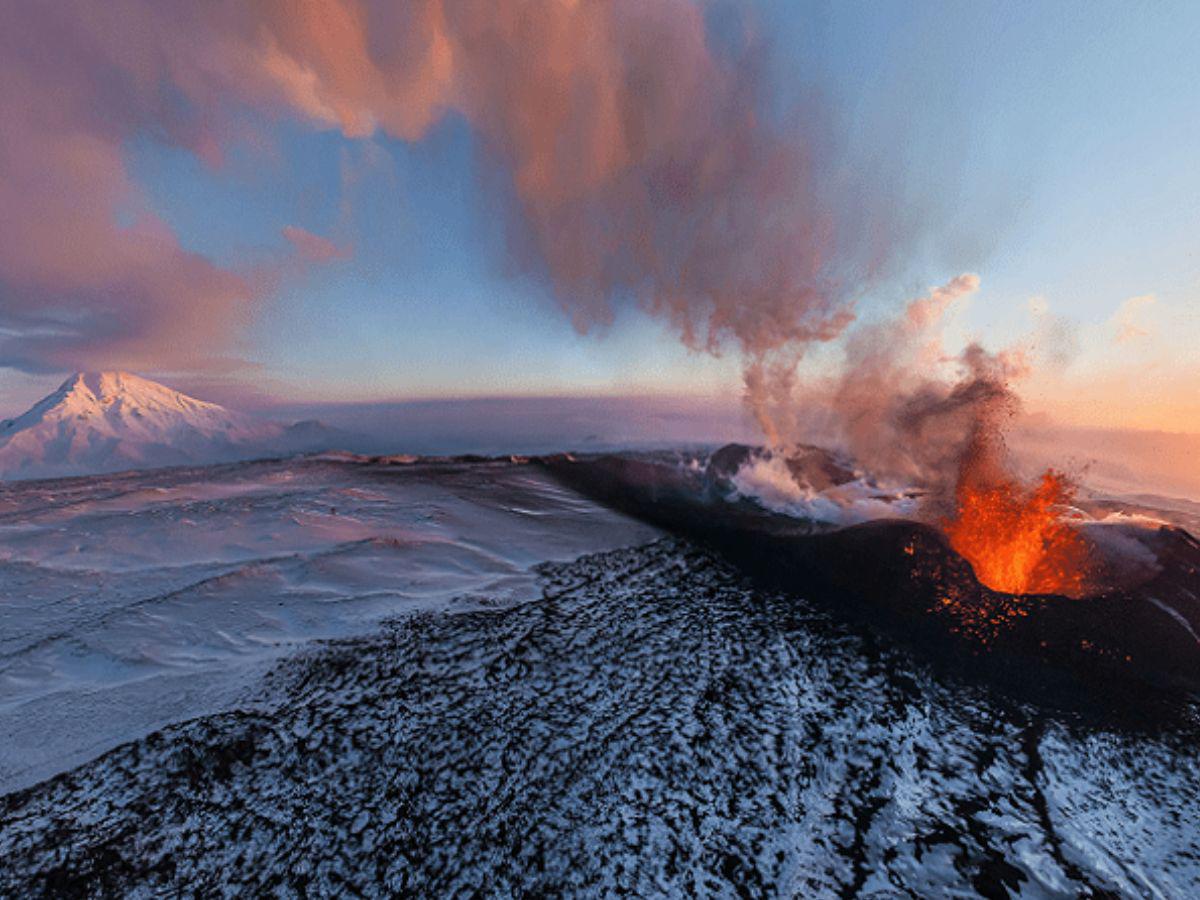Early one morning last December, Aaria Boomla rose from her hard guesthouse bed in the small coastal town of Udvada, India.
It was nothing like her soft bed at home, seven hours away in Pune. She dressed and brushed carefully around her two missing front teeth while silently practicing the lines of scripture she’d been memorizing for months. At age seven, the elder of two children, she was about to join her family as a follower of one of the world’s oldest religions.
The sun came up hot and hazy as Aaria and her family and friends walked along a dirt road to the Iranshah Atash Bahram, a large white stone-and-wood temple complex enclosed behind high walls. The entrance gate, flanked by two enormous sculptures of human-headed, winged bulls, was minded by an attendant who ensured that only those of sufficient ritual purity could enter the temple precinct—one of the most sacred places in all of India.
According to tradition, Aaria’s Zoroastrian ancestors had arrived on the Gujarat coast 1,300 years ago seeking protection from religious persecution by invading Arab Muslims. Here, on the shores of the Arabian Sea, they revived the tenets and rituals of their faith, including a fire sourced from 16 different fires, sparked by everything from a blacksmith’s forge to lightning. That fire has burned continuously ever since, under the careful tending of white-veiled mobeds, or priests. Today it’s for an ever dwindling community of faithful.
Inside the temple precinct, Aaria bathed in sacred water, took three sips of purified bull’s urine, donned a fresh set of white clothes, then joined the mobeds. They gathered around the fire, which burned in a silver urn. Prayers rose into the air, words from a language last in everyday use 3,500 years ago. “Fravaraane mazdayasno Zarathushtrish Vee-daevo Ahura-tkaesho,” Aaria recited: “I confess myself to be a worshipper of the Creator Ahura Mazda, a follower of the religion revealed by the Prophet Zarathushtra.”

In Mumbai, India, Parsi mobeds confer after seven-year-old Shayaan Gazdar’s initiation ceremony, or navjote. Among the most orthodox Parsis (Indian Zoroastrians of Persian descent),only children of Zoroastrian parents can take part in religious rituals.
Photograph by Matthieu Paley
Aaria and her family are among a small and shrinking number of orthodox believers in the corner of the world where Zoroastrianism first appeared and spread. Fewer than 100,000 adherents remain in and around the fringes of the former Persian Empire, in Iran, India, and Pakistan. But in the past century, the faith has traveled far from its origins—to places like Los Angeles, Mexico City, and Stockholm—and inspired new, progressive communities where anyone who follows the tenets of the ancient prophet Zarathushtra can be considered a Zoroastrian.
FREE BONUS ISSUE
(A reborn Persian Empire captured Rome’s lands—and its emperor.)
In much of the world’s imagination, Zoroastrianism conjures up something ancient, and maybe a bit exotic. But the basic tenets are fundamental to people everywhere: good versus evil, resurrection, and the afterlife. At its core is humata, hukhta, hvarshta: “good thoughts, good words, good deeds.”
According to tradition, Zarathushtra—Zoroaster in Greek—was a disillusioned priest of an ancient polytheistic religion who, after immersing himself in a river, received a revelation from Ahura Mazda, the Supreme Being. It’s unclear where and when Zarathushtra might have lived. Many scholars draw clues from Zoroastrian scripture, the Avesta, to place him in Central Asia, possibly modern Afghanistan or Tajikistan, around 1700 to 1000 b.c. He was said to have led just one follower at first, his cousin. But by the sixth century B.C., Zoroastrianism had become tied to the Achaemenian Persian Empire, one of the world’s oldest and largest superpowers, and the tenets of Zarathushtra would eventually spread to lavish Silk Road entrepôts in western China and tiny mountain shrines in the Balkans.
(The controversy behind this Silk Road city’s ancient wonders.)
The Zoroastrian belief in one supreme being and good versus evil had a profound influence on the Abrahamic religions—Judaism, Christianity, and Islam. Cyrus the Great, the founder of the Achaemenian Persian Empire, freed the Jews from captivity in Babylon in 539 b.c. and returned them to Jerusalem, where they rebuilt their temple. Their exposure to Zoroastrianism in Babylonia and Persia, many scholars believe, helped solidify basic elements of Jewish belief, including an afterlife and final judgment. The ancient Greeks noted the wisdom of Zoroastrian sages, which gave rise to the Three Wise Men of the New Testament. And scholars note the similarity between Zoroastrian and Muslim practices of praying five times a day, and the ritual ablution that accompanies these prayers.
The Zoroastrian god is not a negotiating or punishing deity. There’s no notion of original sin that requires repentance. Rather, the Zoroastrian god is more like the force of gravity, indifferent to your daily well-being. Your job is to fight for asha (truth, righteousness, and order) and against druj (filth, lies, and chaos). After death, your soul, or urvan, reunites with your guardian spirit, or fravashi, and lives on in a world of song or a world of purgatory. Then comes the final battle, when good triumphs over evil and everyone is resurrected to live in a perfect world free of war, hunger, and earthly desires.
The teachings of Zarathushtra, in a sense, created the “bookends” of the Abrahamic faiths, says Jamsheed Choksy, a professor of Central Eurasian studies at Indiana University Bloomington. “You start with the discussion of good versus evil, and that humans have a role—that we’re not just walking through life. And at the other end, the reward is that everything will be made right; evil will be defeated.”

An image of the Prophet Zarathushtra hangs in a shrine built around an old well in Mumbai. Scholars believe Zoroastrianism influenced the Abrahamic religions—Judaism, Christianity, and Islam—with concepts of heaven and hell, resurrection, and a single, all-powerful deity.
Photograph by Balazs Gardi
For non-Zoroastrians like me, there’s only so much of the community that’s accessible. Strict purity laws prohibit outsiders from entering the Iranshah temple complex as well as the other smaller fire temples in Udvada. On the morning of Aaria’s initiation, Zarine Bharda pulled up to another fire temple on a white scooter, with a daughter around Aaria’s age in her sidecar. Bharda, dressed all in white, declined my sweaty handshake with an apologetic smile. “If I shook your hand, I’d have to give myself another head bath before I enter the temple,” she explained, pointing to the white kerchief tied around her hair.
A former engineer from a Zoroastrian family in Canada, Bharda is now a women’s wellness coach. Because she’s married to a mobed at the Iranshah temple, she must observe the strictest purity obligations. During menstruation, for instance, she leaves her home for another apartment in town, with separate sets of clothes and dishes. “It’s easier,” she said.
More white-clad worshippers approached the temple, and Bharda’s daughter tugged impatiently at her mom’s sleeve. It was time to go inside.
(In Tajikistan, discover the ruins of a Silk Road kingdom that spread Zoroastrianism.)

Seven-year-old Aaria Boomla departs the Iranshah Atash Bahram, one of India’s holiest sites, after being formally inducted into Zoroastrianism. The sacred fire at this temple has burned for 1,300 years.
Photograph by Matthieu Paley

Ramiyar Karanjia, the principal of a seminary in Mumbai, guides future mobeds as they memorize some 350 pages of the Gathas—accounts of the Prophet Zarathushtra. In Parsi communities, only sons of mobeds may enter the priesthood, though women are taking on priestly roles outside of India
Photograph by Matthieu Paley
India’s Zoroastrians—known as Parsis—claim to be the true custodians of the religion. In the Islamic Republic of Iran, the former center of the Persian Empire, Zoroastrians have been persecuted and forced to take many of their practices underground. Zoroastrianism claimed millions of followers at its height; now there are possibly 15,000 to 25,000 adherents left in Iran. Parsis number around 50,000 in India, concentrated mostly around Mumbai and the state of Gujarat, with less than a thousand more in neighboring Pakistan. The most orthodox of them consider only the children of Zoroastrian parents to be true Parsis, and they frown on marriage outside the faith. These restrictions, coupled with a decreasing birth rate, have led to a rapid decline of the Parsi population.
Ramiyar Karanjia is the principal of a Parsi seminary in the leafy enclave of Dadar in central Mumbai, where the sons of mobeds undergo rigorous training in religious literature and rituals alongside classes in math and geography. A lean, soft-spoken man, Karanjia attended the same boarding school as a child 50 years ago, memorizing scripture and undergoing arduous purification ceremonies required of future mobeds. These include a 25-day isolation inside a fire temple where prepubescent boys are prohibited from touching anything or anyone, or eating between sunrise and sundown.

Eroding citadels in Uzbekistan harbor remnants of a fire temple built by Zoroastrians, who revere fire as a sacred element.
Photograph by Matthieu Paley
The core scripture, the Avesta, contains 17 Gathas, the words delivered from Ahura Mazda to his prophet, Zarathushtra. The oldest passages are in Old Avestan, a language believed to have been spoken in Central Asia during the Bronze Age some 3,500 years ago. Then there is the Vendidad, mostly a compendium of ecclesiastical and social laws that’s considered to be one of 21 books that made up the original Zoroastrian corpus. It’s the only one that survived fully intact following the sack of the Persian Empire by Alexander the Great—or “Alexander the Accursed,” as he’s known in these parts—in 330 b.c. Maybe 10 percent of Zoroastrian scripture in Avestan survives to this day, said Karanjia.
Zoroastrian communities look to their mobeds for leadership. In Parsi tradition, only the sons of priests can become priests. A mobed may make only 50,000 rupees a year, Karanjia explained—about $600, a meager sum even in the poorest parts of India—and there’s no medical plan or pension. So most mobeds serve part-time and enter other professions.
Not long ago, more than two dozen students attended the Dadar seminary. “Presently we have just 14,” lamented Karanjia. The only other Parsi seminary hasn’t had any students in almost a decade.
The small number of seminary candidates is a reflection of a low fertility rate in Parsi communities. Religious leaders and researchers note that Parsi men and women tend to marry older, if at all, and have fewer children than they once did. It’s estimated that for every Parsi born into the community, four pass away. Jiyo Parsi, a program launched in 2013 and sponsored in part by the Indian government, promoted larger Parsi families with financial incentives, counseling, fertility treatments, and cheeky ad campaigns. “Be responsible. Don’t use a condom tonight,” urged one poster. Some Parsis are humorously fatalistic about the future of their community. “You know that movie Four Weddings and a Funeral?” a Parsi journalist asked me. “With us, it’s Four Funerals and a Wedding.”
Rohinton Nariman, a mobed and former Indian Supreme Court judge, conceded that bias against intermarriage will doom the Parsis. “North America is the only place now which is accepting both the spouses as well as the children,” he said. “And I’m sure Zoroastrianism will flourish there.”
Behmam Abadian’s trophy warehouse sits in an unassuming industrial park in Glendale, California. Inside, the shelves are filled with dazzling bronze, glass, and zinc confections bound for corporate executives, professional athletes, and Scientologists. Abadian is a civil engineer who left Iran the day Iraq invaded in 1980, eventually marrying “a Muslim woman in a Catholic church in New York City,” he said. Today he’s a trustee of the California Zoroastrian Center, and he distributes progressive-minded books on the faith for his brethren in North America. Apart from the books, Abadian is particularly proud of his latest work: a 10-foot-tall bronze statue of Cyrus the Great.
I joined Abadian and his friend Arman Ariane for lunch at a popular Persian restaurant near the trophy warehouse. Inside, waiters carrying platters of flatbread and grilled meats maneuvered between packed tables of dressed-up families. It was the weekend of Nowruz, the Zoroastrian New Year that begins on the spring equinox in March.

Family and friends celebrate Nowruz (Zoroastrian New Year) at the home of Arman Ariane (second from right) in Claremont, California. In contrast to India’s Parsis, who don’t seek or accept converts, most Zoroastrian groups in North America are open to all.
Photograph by Balasz Gardi

Praying before the flame of their faith, Setareh Mandegarian and son Kiyan Khadem light a candle in celebration of Nowruz at the California Zoroastrian Center in Westminster.
Photograph by Balasz Gardi
While it’s impossible to say how closely Cyrus the Great followed the tenets of Zarathushtra, modern Zoroastrians point with pride to the way the Persian king restored the temples of many faiths under the guardianship of one of the world’s first superpowers—creating, essentially, the first multireligion empire. “And it led to the world’s first declaration of human rights,” said Ariane, a fashion designer and owner of Xerxes for Gents, a clothing store in nearby Claremont. Originally from Iran, Ariane was attending boarding school in Austria when Ayatollah Khomeini seized power in early 1979. Ariane found himself without a home, so he worked as a truck driver for a year, then restarted his life in Los Angeles delivering pizza.
You May Also Like
While the first Zoroastrian populations appeared in North America in the 1950s following the independence and partition of India and Pakistan, they saw exponential growth during the 1970s and ’80s, fueled both by Iranians fleeing the 1979 revolution and subsequent war with Iraq and by the economic migration of Zoroastrians from South Asia. Today it’s a stable community rather than one declining under the burden of ethnoreligious restrictions, notes Choksy, the professor of Central Eurasian studies. Families are younger, intermarriage more common. “The perspective is very much one of a younger community that sees possibilities,” Choksy said.
The Federation of Zoroastrian Associations of North America (FEZANA) was established in 1987 as a sort of umbrella for two dozen Zoroastrian groups across Canada and the United States. Ariane plays a role in a number of Zoroastrian organizations in California and beyond, and helps run a Facebook group for converts. The group is one of many Zoroastrian communities that thrive online, including the Norway-based Great Return, which is initiating Zoroastrians around the world.
Younger Zoroastrians tend to meet up on WhatsApp and Instagram, according to Arzan Sam Wadia, a New York–based architect and current president of FEZANA who also runs Return to Roots, which connects young Zoroastrian adults in the diaspora to their ancestral communities in India.
Today more than 25,000 Zoroastrians live in North America. How many more, and how quickly that number is growing, is hard to say. Iranian Zoroastrians don’t necessarily want to be counted, Wadia explained: “They’ll say, ‘Here is my membership money, don’t take my phone number, don’t take my email address.’ They still have the Big Brother kind of fear.”
At the same time, newly arrived Indian Zoroastrians in North America as well as second- and third-generation descendants may avoid joining their local communities because of the looming influence of Parsi orthodoxy. “They’ll say, Oh, but I married a Hindu, I married an American guy, so I’m not going to be allowed,” said Wadia. “I’ll say, Who told you that? Everybody is allowed. Even non-Zoroastrians can enter our place of fire and actually worship. We are not going by the same set of standards and rules that we have in India.”
Ariane calls himself a Zoroastrian by choice, having grown up in a secular household with Muslim parents. He finds solace in the faith’s emphasis on free will and personal responsibility.
“We are in the driver’s seat, and we have to take control. We can make this a better world and not have to wait for a savior to show up,” he said. “Many religions are waiting for a savior to come and solve all the problems. And you’re forgetting that it’s us who needs to make the move.
“We were given brains and knowledge,” he continued. “It’s our responsibility to use it for good things.”
To progressive followers like Ariane, Zoroastrianism is open to all, unencumbered by the restrictions and rituals put on the religion in later literature. The focus of the faith rests on the Gathas, hymns reflecting the conversations between the Prophet Zarathushtra and the Supreme Being, Ahura Mazda. Gathas are devoid of commandments. Zoroastrian prayer is mostly a series of meditations on what one should do. “What do the millennials call it?” Ariane asked. “Manifesting?”
Malabar Hill is one of the priciest neighborhoods in the growing megacity of Mumbai, where more than 20 million residents vie for living space in ever higher apartment buildings. But Doongerwadi forest, 55 acres of wooded calm where Parsis have disposed of their dead for centuries, remains a respite in the center of the chaos. “These are the lungs of Mumbai,” said Rashneh Pardiwala, waving her hand at the tall banyan and mango trees around us. Pardiwala, a Parsi, is the founder of India’s Centre for Environmental Research and Education. She grew up near these woods as a practicing Zoroastrian.
The faith’s scriptures outline the care that must be taken to avoid defiling water, earth, and fire. One way Zoroastrians did this for millennia was by placing dead bodies on mountaintops and in dakhmas, or “towers of silence,” where the flesh is eaten by scavengers. The Parsis started building their towers of silence three centuries ago in Doongerwadi, on what was then the outskirts of Mumbai. Today, the five circular towers are overshadowed by enormous apartment blocks. A stone wall encircles the precinct, accessed by a single road that ends atop a hill dotted with a few low-slung buildings.
Non-Zoroastrians attending burials in Doongerwadi are allowed only in two open-air guest pavilions and are prohibited from going anywhere near the towers. Even Parsis are prohibited from exploring the forest and disturbing the purity of the soil beyond the paths to the towers. But Pardiwala persuaded the community board that manages the forest to allow her to study a five-acre parcel. Since then, she’s revived parts of the forest with more than 12,000 saplings from more than 50 types of native trees.
In the hushed, green expanse of Doongerwadi, surrounded by the vastness of modern Mumbai, there’s a constant reminder of the endless march of progress and its unintended consequences, which can alter even the most ancient of religions. The native vultures that Zoroastrians have relied on to dispose of their dead are long gone from the forest, inadvertently poisoned by a drug used to treat Indian cattle in the 1990s. Caretakers now rely on solar concentrators to hasten decomposition—and reduce complaints from neighbors.
Pardiwala and I settled in on heavy wooden benches in Doongerwadi’s century-old guest pavilion, recently renovated by her family. Her mother, she quietly noted, died just before its completion and was unable to see how it turned out. “Look at the stained glass,” she said, pointing up at a colorful panel depicting mobeds praying over a sacred fire and a dog—believed to be a steadfast spiritual friend of Zoroastrians, which helps guide the human soul from this life to what follows.
For more than three millennia, followers of Zarathushtra have memorized and repeated the Ashem Vohu, one of the faith’s most important prayers. One translation goes like this:
Righteousness is the best good and it is happiness.
Happiness is to her/him who is righteous
for the sake of the best righteousness.
In the chaotic first decades of the 21st century, as old orders collapse and truth, asha, is increasingly difficult to discern from lies, druj, there’s solace in this prayer, both in the simplicity of its message and the challenge it poses. It’s a challenge that Zoroastrians have aspired to meet for millennia—from the spiritual leaders of an empire and the tenders of centuries-old fires to modern generations trying to nudge the universe toward a more perfect order.
Enormous crows swooped between Doongerwadi’s soaring trees, filling the air with their insistent caws. Suddenly, two white-veiled mobeds emerged from a nearby building with a leashed dog. They’re followed by the body of a recently deceased Parsi, wrapped in a white shroud and carried on a metal bier. “Stand up,” Pardiwala whispered. The funeral procession moved past us and up the hill toward a tower of silence. A handful of other dogs lazing in the shade got up and trotted behind the procession. Then all disappeared into the forest and the golden afternoon light.
This story appears in the May 2024 issue of National Geographic magazine.
Matthieu Paley, an Explorer since 2019, specializes in photographing little-known communities, including Zoroastrians. Much of his coverage spotlights the people and peaks of the western Himalaya.




